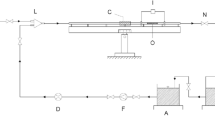Abstract
The formation of slug in the horizontal pipes due to the hydrodynamic instabilities has always been of great interest to many researchers. In this research, the effect of various numerical methods on the simulation of slug flow initiation using pressure-free two-fluid model has been investigated. The two-fluid model has been solved by conservative shock-capturing method. When the slug is formed, a strong discontinuity will be developed in the flow stream. Therefore, a numerical method should have the capability to predict this discontinuity with high accuracy and should not have oscillation near the discontinuity. There are three different models to simulate two-phase flow systems: homogeneous equilibrium model, drift-flux model, and two-fluid model. This research used two-fluid model for predicting the slug flow initiation through a pipe. Four different numerical two-fluid methods, namely Lax-Friedrichs, Rusanov, Richtmyer and flux-corrected transport (FCT) have been used in this research. Results show that FCT is the most accurate method for the prediction of the slug flow initiation among other methods where Rusanov and Lax-Friedrichs numerical methods were in the next steps, respectively. Due to the oscillatory nature near the discontinuity caused by formation of slug regime, the Richtmyer numerical method is not an appropriate method for modeling slug flow regime. Results also show that as the numerical diffusion of these methods reduces in the flow field, the slug flow initiation will be predicted with higher accuracy.













Similar content being viewed by others
References
Ansari MR (1998) Dynamical behavior of slug initiation generated by short waves in two-phase air-water stratified flow. ASME Heat Transf Div Publ HTD 361:289–296
Ansari M, Shokri V (2011) Numerical modeling of slug flow initiation in a horizontal channels using a two-fluid model. Int J Heat Fluid Flow 32(1):145–155
Bonizzi M, Issa R (2003a) A model for simulating gas bubble entrainment in two-phase horizontal slug flow. Int J Multiph Flow 29(11):1685–1717
Bonizzi M, Issa R (2003b) On the simulation of three-phase slug flow in nearly horizontal pipes using the multi-fluid model. Int J Multiph Flow 29(11):1719–1747
Bonzanini A, Picchi D, Poesio P (2017) Simplified 1D incompressible two-fluid model with artificial diffusion for slug flow capturing in horizontal and nearly horizontal pipes. Energies 10(9):1372
Boris JP, Book DL (1973) Flux-corrected transport. I. SHASTA, a fluid transport algorithm that works. J Comput Phys 11(1):38–69
Carneiro J, Ortega A, Nieckele A (2005) Influence of the interfacial pressure jump condition on the simulation of horizontal two-phase slug flows using the two-fluid model. WIT Trans Eng Sci 50(3):123–132
Cazarez-Candia O, Benitez-Centeno O, Espinosa-Paredes G (2011) Two-fluid model for transient analysis of slug flow in oil wells. Int J Heat Fluid Flow 32(3):762–770
Conte MG, Cozin C, Barbuto FA, Morales RE (2014) A two-fluid model for slug flow initiation based on a lagrangian scheme. In: Proceeding of the American society of mechanical engineers, pp V002T20A003–V002T20A003
Hanyang G, Liejin G (2005) Stability of stratified flow and slugging in horizontal gas–liquid flow. Prog Nat Sci 15(11):1026–1034
Hirsch H (1990) Numerical computation of internal and external flows. Comput Methods Inviscid Viscous Flows 2:536–556
Hoffmann KA, Chiang ST (2000) Computational fluid dynamics volume I. In: Engineering education system, Wichita, Kan, USA
Hua J, Langsholt M, Lawrence C (2012) Numerical simulation of single elongated bubble propagation in inclined pipes. Progr Comput Fluid Dyn, Int J 12(2–3):131–139
Ishii M (1975) Thermo-fluid dynamic theory of two-phase flow. Eyrolles, Paris
Ishii M, Mishima K (1984) Two-fluid model and hydrodynamic constitutive relations. Nucl Eng Des 82(2):107–126
Issa R, Kempf M (2003) Simulation of slug flow in horizontal and nearly horizontal pipes with the two-fluid model. Int J Multiph Flow 29(1):69–95
Issa R, Bonizzi M, Barbeau S (2006) Improved closure models for gas entrainment and interfacial shear for slug flow modelling in horizontal pipes. Int J Multiph Flow 32(10):1287–1293
Issa R, Castagna J, Sheikh A (2011) Accurate simulation of intermittent/slug flow in oil and gas pipelines. In: 15th international conditioning on multiphase production technology, Cannes, France, June 15–17
Louaked M, Hanich L, Thompson C (2003) Well-posedness of incompressible models of two-and three-phase flow. IMA J Appl Math 68(6):595–620
Montini M (2011) Closure relations of the one-dimensional two-fluid model for the simulation of slug flows. PhD Thesis, Imperial College London, London
Omgba-Essama C (2004) Numerical modelling of transient gas–liquid flows (application to stratified & slug flow regimes). PhD Thesis, Cranfield University
Ransom VH, Hicks DL (1984) Hyperbolic two-pressure models for two-phase flow. J Comput Phys 53(1):124–151
Shokri V, Esmaeili K (2017) Comparison of the effect of hydrodynamic and hydrostatic models for pressure correction term in two-fluid model in gas–liquid two-phase flow modeling. J Mol Liq 237:334–346
Simões EF, Carneiro JN, Nieckele AO (2014) Numerical prediction of non-boiling heat transfer in horizontal stratified and slug flow by the Two-Fluid Model. Int J Heat Fluid Flow 47:135–145
Ujang PM, Lawrence CJ, Hale CP, Hewitt GF (2006) Slug initiation and evolution in two-phase horizontal flow. Int J Multiph Flow 32(5):527–552
Wallis GB (1969) One-dimensional two-phase flow. McGraw-Hill Companies, New York
Wang X, Guo L, Zhang X (2007) An experimental study of the statistical parameters of gas–liquid two-phase slug flow in horizontal pipeline. Int J Heat Mass Transf 50(11):2439–2443
Watson M (1990) Non-linear waves in pipeline two-phase flows. In: Third international conference on hyperbolic problems
Woodburn P, Issa R (1998) Well-posedness of one-dimensional transient, two-fluid models of two-phase flows. In: Third international conditioning of multiphase flow, Lyon, France, June 8–12
Zeng Q, Aydemir N, Lien F, Xu T (2015) Comparison of implicit and explicit AUSM-family schemes for compressible multiphase flows. Int J Numer Meth Fluids 77(1):43–61
Author information
Authors and Affiliations
Corresponding author
Rights and permissions
About this article
Cite this article
Zolfaghary Azizi, H., Naghashzadegan, M. & Shokri, V. Comparison of Numerical Methods for Two-Fluid Model for Gas–Liquid Transient Flow Regime and Its Application in Slug Modeling Initiation. Iran J Sci Technol Trans Mech Eng 43, 663–673 (2019). https://doi.org/10.1007/s40997-018-0231-4
Received:
Accepted:
Published:
Issue Date:
DOI: https://doi.org/10.1007/s40997-018-0231-4




